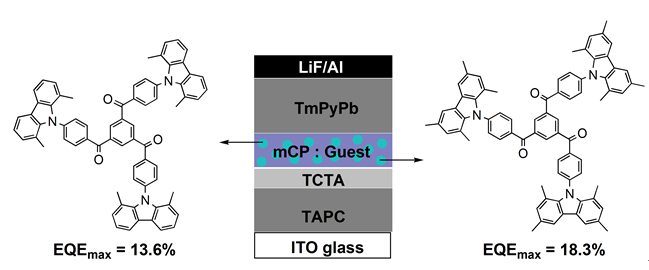[1] Sun, Y. R.; Giebink, N. C.; Kanno, H.; Ma, B. W.; Thompson, M. E.; Forrest, S. R. Nature 2006, 440, 908.
[2] Reineke, S.; Lindner, F.; Schwartz, G.; Seidler, N.; Walzer, K.; Lussem, B.; Leo, K. Nature 2009, 459, 234.
[3] Helander, M. G.; Wang, Z. B.; Qiu, J.; Greiner, M. T.; Puzzo, D. P.; Liu, Z. W. Science 2011, 332, 944.
[4] Han, T.-H.; Lee, Y.; Choi, M.-R.; Woo, S.-H.; Hong, B. H.; Ahn, J.-H.; Lee, T.-W. Nat. Photonics 2012, 459, 105.
[5] Sasabe, H.; Kido, J. J. Mater. Chem. C 2013, 1, 1699.
[6] Chen, S.; Dai, J.; Zhou, K.; Luo, Y.; Su, S.; Pu, X.; Huang, Y.; Lu, Z. Acta Chim. Sinica 2017, 75, 367. (陈仕琦, 代军, 周凯峰, 罗艳菊, 苏仕健, 蒲雪梅, 黄艳, 卢志云, 化学学报, 2017, 75, 367.)
[7] Qiu, Z.; Tan, J.; Cai, N.; Wang, K.; Ji, S.; Huo, Y. Chin. J. Org. Chem. 2019, 39, 679. (邱志鹏, 谭继华, 蔡宁, 王凯, 籍少敏, 霍延平, 有机化学, 2019, 39, 679.)
[8] He, X.; Xiao, Y.; Yuan, X.; Ye, S.; Jiang, H. Chin. J. Org. Chem. 2019, 39, 761. (何煦, 肖燏萍, 袁鑫磊, 叶尚辉, 姜鸿基, 有机化学, 2019, 39, 761.)
[9] Wang, F.; Cao, X.; Mei, L.; Zhang, X.; Hu, J.; Tao, Y. Chin. J. Chem. 2018, 36, 241.
[10] Zhou, W.; Liu, Z.; Wang, Z.; Hu, S.; Liang, A. Chin. J. Org. Chem. 2019, 39, 1214. (周文静, 刘志谦, 王志平, 胡斯帆, 梁爱辉, 有机化学, 2019, 39, 1214.)
[11] Xu, H.; Chen, R.; Sun, Q.; Huang, W.; Liu, X. Chem. Soc. Rev. 2014, 43, 3259.
[12] Volz, D.; Wallesch, M.; Fléchon, C.; Danz, M.; Verma, A.; Navarro, J. M.; Zink, D. M.; Bräse, S.; Baumann, T. Green Chem. 2015, 17, 1988.
[13] Chi, Y.; Tong, B.; Chou, P.-T. Coord. Chem. Rev. 2014, 281, 1.
[14] Uoyama, H.; Goushi, K.; Shizu, K.; Nomura, H.; Adachi, C. Nature 2012, 492, 234.
[15] Dias, F. B.; Bourdakos, K. N.; Jankus, V.; Moss, K. C.; Kamtekar, K. T.; Bhalla, V.; Santos, J.; Bryce, M. R.; Monkman, A. P. Adv. Mater. 2013, 25, 3707.
[16] Zhang, D. D.; Duan, L. A.; Li, Y. L.; Zhang, D. Q.; Qiu, Y. J. Mater. Chem. C 2014, 2, 8191.
[17] Wang, H.; Xie, L.; Peng, Q.; Meng, L.; Wang, Y.; Yi, Y.; Wang, P. Adv. Mater. 2014, 26, 5198.
[18] Mei, L.; Hu, J.; Cao, X.; Wang, F.; Zheng, C.; Tao, Y.; Zhang, X.; Huang, W. Chem. Commun. 2015, 51, 13024.
[19] Cai, X.; Li, X.; Xie, G.; He, Z.; Gao, K.; Liu, K.; Chen, D.; Cao, Y.; Su, S. J. Chem. Sci. 2016, 7, 4264.
[20] Meng, L.; Wang, H.; Wei, X.; Liu, J.; Chen, Y.; Kong, X.; Lv, X.; Wang, P.; Wang, Y. ACS Appl. Mater. Interfaces 2016, 8, 20955.
[21] Wang, K.; Zheng, C. J.; Liu, W.; Liang, K.; Shi, Y. Z.; Tao, S. L.; Lee, C. S.; Ou, X. M.; Zhang, X. H. Adv. Mater. 2017, 29, 1701476.
[22] Lee, J.; Aizawa, N.; Yasuda, T. Chem. Mater. 2017, 29, 8012.
[23] Shi, Y. Z.; Wang, K.; Li, X.; Dai, G. L.; Liu, W.; Ke, K.; Zhang, M.; Tao, S. L.; Zheng, C. J.; Ou, X. M.; Zhang, X. H. Angew. Chem., Int. Ed. 2018, 57, 9480.
[24] Yu, L.; Wu, Z.; Xie, G.; Zeng, W.; Ma, D.; Yang, C. Chem. Sci. 2018, 9, 1385.
[25] Yang, Z.; Mao, Z.; Xu, C.; Chen, X.; Zhao, J.; Yang, Z.; Zhang, Y.; Wu, W.; Jiao, S.; Liu, Y.; Aldred, M. P.; Chi, Z. Chem. Sci. 2019, 10, 8129.
[26] Zhang, M.; Liu, W.; Zheng, C. J.; Wang, K.; Shi, Y. Z.; Li, X.; Lin, H.; Tao, S. L.; Zhang, X. H. Adv. Sci. 2019, 6, 1801938.
[27] Rajamalli, P.; Senthilkumar, N.; Gandeepan, P.; Huang, P. Y.; Huang, M. J.; Ren-Wu, C. Z.; Yang, C. Y.; Chiu, M. J.; Chu, L. K.; Lin, H. W.; Cheng, C. H. J. Am. Chem. Soc. 2016, 138, 628.
[28] Xie, Z.; Chen, C.; Xu, S.; Li, J.; Zhang, Y.; Liu, S.; Xu, J.; Chi, Z. Angew. Chem., Int. Ed. 2015, 54, 7181.
[29] Nikolaenko, A. E.; Cass, M.; Bourcet, F.; Mohamad, D.; Roberts, M. Adv. Mater. 2015, 27, 7236.
[30] Di, D.; Romanov, A. S.; Yang, L.; Richter, J. M.; Rivett, J. P. H.; Jones, S.; Thomas, T. H.; Jalebi, M. A.; Friend, R. H.; Linnolahti, M.; Bochmann, M.; Credgington, D. Science 2017, 356, 159.
[31] Wang, Z.; Zheng, C.; Wang, W.; Xu, C.; Ji, B.; Zhang, X. Inorg. Chem. 2016, 55, 2157.
[32] Wang, Z.; Sun, X.; Xu, C.; Ji, B. Front. Chem. 2019, DOI:10. 3389/fchem. 2019.00422
[33] Song, X.; Zhang, D.; Lu, Y.; Yin, C.; Duan, L. Adv. Mater. 2019, 31, 1901923.
[34] Kretzschmar, A.; Patze, C.; Schwaebel, S. T.; Bunz, U. H. F. J. Org. Chem. 2015, 80, 9126.
[35] Zhu, Y.; Zhang, Y.; Yao, B.; Wang, Y.; Zhang, Z.; Zhan, H.; Zhang, B.; Xie, Z.; Wang, Y.; Cheng, Y. Macromolecules 2016, 49, 4373.
[36] Wang, Z.; Cai, J.; Zhang, M.; Zheng, C.; Ji, B. Acta Chim. Sinica 2019, 77, 263. (王志强, 蔡佳林, 张明, 郑才俊, 吉保明, 化学学报, 2019, 77, 263.)
[37] Yang, Z.; Mao, Z.; Xie, Z.; Zhang, Y.; Liu, S.; Zhao, J.; Xu, J.; Chi Z.; Aldred, M. P. Chem. Soc. Rev. 2017, 46, 915.
[38] Huang, T.; Jiang, W.; Duan, L. J. Mater. Chem. C 2018, 6, 5577.
[39] Godumala, M.; Choi, S.; Cho, M. J.; Choi, D. H. J. Mater. Chem. C 2019, 7, 2172.
[40] Cao, X.; Zhang, D.; Zhang, S.; Tao, Y.; Huang, W. J. Mater. Chem. C 2017, 5, 7699.
[41] Godumala, M.; Choi, S.; Cho, M. J.; Choi, D. H. J. Mater. Chem. C 2016, 4, 11355.
[42] Cai, X.; Chen, D.; Gao, K.; Gan, L.; Yin, Q.; Qiao, Z.; Chen, Z.; Jiang, X.; Su, S.-J. Adv. Funct. Mater. 2017, 27, 1704927.
[43] Bai, M.-D.; Zhang, M.; Wang, K.; Shi, Y.-Z.; Chen, J.-X.; Lin, H.; Tao, S.-L.; Zheng, C.-J.; Zhang, X.-H. Org. Electron. 2018, 62, 220. |
